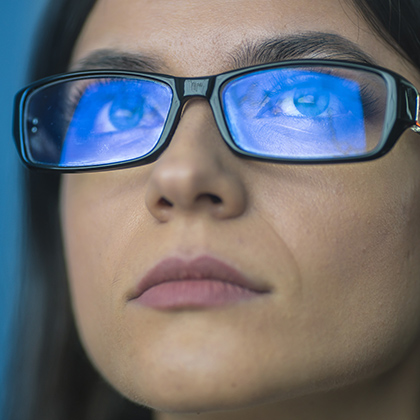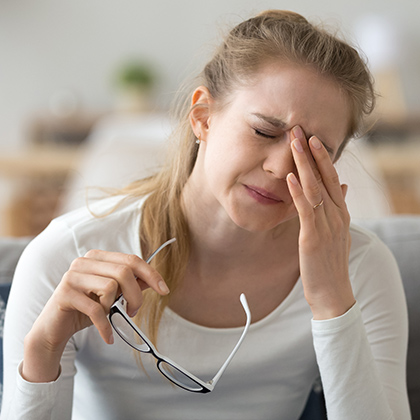
You may not know much about blue light, but if you spend any amount of time staring at a computer, a tablet, a flatscreen TV or a smartphone, you’re effectively exposing yourself to it. Blue light is also part of sunlight, so you’re getting a hit when you go outdoors too, even when it’s cloudy (sunlight is by far the strongest source). For more in depth detail on blue light, check out our piece on its impact on our overall eye health. But what you’re probably wondering is why has blue light become such a controversial topic? And why do some companies suggest you should take steps to protect your eyes from it?
Our use of blue light devices
Since the technology that produces blue light is relatively new, research into its potential effects on eye health is still in its infancy. However, one reason people are so concerned about it is that we’re spending so much time using blue-light-emitting digital devices these days. A 2017 report by global measurement and data analytics company Nielsen suggests many of us spend more time looking at digital screens than we do sleepingi.
Based on US data, the report suggests the average adult spends eight hours and 58 minutes a day using a digital device, up from seven hours and 20 minutes in 2015 (UK surveys report similar findings). According to The Sleep Council’s Great British Bedtime Report, meanwhile, the majority of people in this country sleep for less than seven hours per nightii.
That many of us spend so much time staring at a screen is hardly surprising, as it’s become normal for many employees to spend their entire working day in front of a computer. Even if we take regular breaks, chances are we spend at least part of them checking our smartphones. Then when we get home, we may spend another few hours watching TV or using a tablet or laptop.
Is blue light harmful or harmless?
As to whether blue light is a threat to human eye health, the evidence so far is unclear, and experts have yet to find any substantial evidence that blue light damages eyesight (animal trials have found it may harm the light-sensitive part of the eye called the retinaiii, but studies involving animals are of limited usefulness to human health and wellbeing).
 However, we know other forms of light can be harmful to eye health. Ultraviolet (UV) light, for instance, is largely absorbed by the front of the eye, while most blue light passes through and reaches the retina. Yet UV has been linked to a number of eye conditions, including cataractsvi, age-related macular degeneration (AMD)v, photokeratitisvi (also known as snow blindness) and even eye cancervii.
However, we know other forms of light can be harmful to eye health. Ultraviolet (UV) light, for instance, is largely absorbed by the front of the eye, while most blue light passes through and reaches the retina. Yet UV has been linked to a number of eye conditions, including cataractsvi, age-related macular degeneration (AMD)v, photokeratitisvi (also known as snow blindness) and even eye cancervii.
Another factor fueling the concern over blue light is that many people experience eye strain or dry eyes when using computer or smartphone screens. And while it’s acknowledged that screen-related eye strain can be caused by low blink rates – since we tend to blink less when looking at a digital screen – we don’t yet know if it could be linked with blue light exposure tooviii.
Ways to protect your eyesight from blue light
At this moment we know far less about blue light than UV light. So if you’re concerned about the amount of blue light you’re exposed to and the possible problems it might cause, here’s what you can do right now to protect yourself and your family:
Switch off devices before bedtime
While there may not yet be any solid evidence to suggest blue light is harmful to your eyes, studies show it can interfere with sleep because of the effect it has on human circadian rhythms and because it suppresses a sleep-inducing hormone called melatoninix.This is why the Association of Optometrists recommends switching off digital devices an hour before turning inx. If you have a device that lets you reduce the amount of blue light it emits, reduce the blue light setting in the evening too.
Adjust your screen set-up
If you spend most of your working day in front of a computer screen it’s a good idea to make sure it’s set up properly. Adjust the brightness of your screen so that it matches the ambient light levels in the room, and if your screen has a colour temperature control, try turning down the amount of blue light it displays (you can do this with the Nightshift setting on a Mac, with Blue Light Settings in Windows 10, and with Night Mode on an Android device). Your screen should also be about 20 - 30 inches away from you, and the top of your monitor should be in line with your eyes (this means you’xi look down by 15 - 20 degrees when you view the centre of the screen).
Take regular breaks
It’s a good idea to give your eye muscles a break when you’re using digital screens. The 20-20-20 rule says you should take a 20-second break from your screen every 20 minutes by looking at something at least 20ft away to help the focusing muscles in your eyes relax. Also try to make a conscious effort to blink more frequently – if your eyes start feeling dry or tired, look away from your screen and blink slowly 10 times.
Eat for your eyes
Eating a healthy balanced diet that includes a good variety of coloured fruits and vegetables means your vision can get the nutrients it needs – find out more by reading Healthy Eyes: Dietary Considerations to Improve Your Vision.
Get regular check-ups
Lower your risk of having an undiagnosed vision problem by going for regular eye tests, as often as your optician advises (find your nearest NHS optician).
Meanwhile many companies, including some opticians, recommend using blue light blocking glasses to filter the amount of blue light entering your eyes. There is, however, a lot of debate about whether or not these products are effective.
Interested in keeping your vision healthy? Take a look at the other articles in our Vision Health Hub.
References:
-
The Nielsen Total Audience Report. Q2 2017. Available online: https://www.nielsen.com/us/en/insights/reports/2017/the-nielsen-total-audience-q2-2017.html
-
The Sleep Council. The Great British Bedtime Report . Available online: https://sleepcouncil.org.uk/wp-content/uploads/2018/04/The-Great-British-Bedtime-Report-2017.pdf
-
Seko, Y., Pang, J., Tokoro, T., Ichinose, S., Mochizuki, M. Blue light-induced apoptosis in cultured retinal pigment epithelium cells of the rat. Graefes Arch Clin Exp Ophthalmol. 2001 Jan. ;239(1):47-52. Available online: https://www.ncbi.nlm.nih.gov/pubmed/11271461
Ham, W.T., Ruffolo, J.J., Mueller, H.A. & Guerry, D.The nature of retinal radiation damage: dependence on wavelength, power level and exposure time. Vision Research, Volume 20, Issue 12. 1980. Pages 1105-1111. Available online: https://www.sciencedirect.com/science/article/pii/0042698980900474 -
Cataracts: Dolin PJ Ultraviolet radiation and cataract: a review of the epidemiological evidence. British Journal of Ophthalmology. 1994. ;78: 478-482. Available online: https://bjo.bmj.com/content/bjophthalmol/78/6/478.full.pdf
-
AMD: Chalam, K.V., et al. A review: role of ultraviolet radiation in age-related macular degeneration. Eye Contact Lens. 2011 Jul. ;37(4):225-32. Available online: https://www.ncbi.nlm.nih.gov/pubmed/21646979
-
Porter, D. What Is Photokeratitis. American Academy of Ophthalmolgy. (September 2017). Available online: https://www.aao.org/eye-health/diseases/photokeratitis-snow-blindness
-
World Health Organization. The Known Effects of UV. Available online: https://www.who.int/uv/faq/uvhealtfac/en/index3.html Date Accessed: 23/01/2019.
-
Sheppard, A.L., Wolffson, J.S. Digital eye strain: prevalence, measurement and amelioration. BMJ Open Opthalmology, Vol 3, Issue 1. Available online: https://bmjophth.bmj.com/content/3/1/e000146
-
Chang, A.M., et al. Evening use of light-emitting eReaders negatively affects sleep, circadian timing, and next-morning alertness. Proc Natl Acad Sci U S A. (2015 Jan 27) ;112(4):1232-7. Available online: https://www.ncbi.nlm.nih.gov/pubmed/25535358
-
Available online: https://www.aop.org.uk/advice-and-support/for-patients/a-b-see-campaign/five-ways-to-protect-your-childrens-eyes/put-digital-screens-away-at-bedtime
Related Posts?
Disclaimer: The information presented by Nature's Best is for informational purposes only. It is based on scientific studies (human, animal, or in vitro), clinical experience, or traditional usage as cited in each article. The results reported may not necessarily occur in all individuals. Self-treatment is not recommended for life-threatening conditions that require medical treatment under a doctor's care. For many of the conditions discussed, treatment with prescription or over the counter medication is also available. Consult your doctor, practitioner, and/or pharmacist for any health problem and before using any supplements or before making any changes in prescribed medications.

Christine
Christine Morgan has been a freelance health and wellbeing journalist for almost 20 years, having written for numerous publications including the Daily Mirror, S Magazine, Top Sante, Healthy, Woman & Home, Zest, Allergy, Healthy Times and Pregnancy & Birth; she has also edited several titles such as Women’ Health, Shine’s Real Health & Beauty and All About Health.
View More



